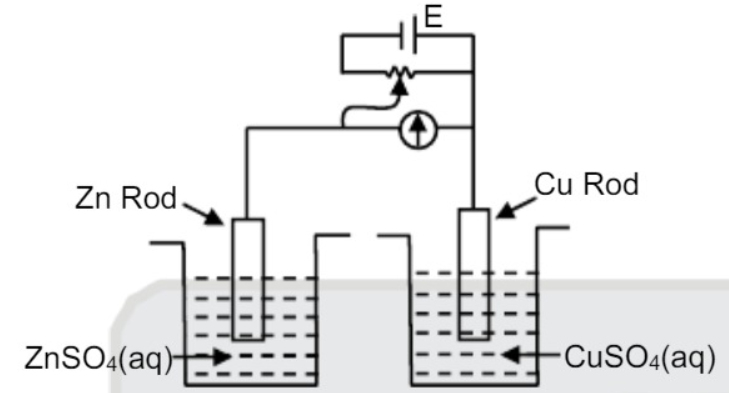If a small Cu rod is placed in an aqueous solution of ferrous salt, then which of the following will be observed? (E0Cu2−Cu=−0.34V,E0Fe2+Fe=−0.44V)
Copper will be oxidised
Fe2+ will be reduced
No reaction will take place
Fe2+will be oxidised
The correct Answer is:C
To solve the question, we need to analyze the electrochemical behavior of copper (Cu) when placed in an aqueous solution of ferrous salt (Fe²⁺).
1. Understanding the Electrochemical Series:
- The electrochemical series ranks metals based on their standard reduction potentials. The higher the reduction potential, the more likely the species will be reduced (gain electrons).
- Given values:
- E∘(Cu2+/Cu)=−0.34V
- E∘(Fe2+/Fe)=−0.44V
2. Comparing the Reduction Potentials:
- Since copper has a higher reduction potential (-0.34 V) compared to iron (-0.44 V), copper is more likely to remain in its elemental form rather than oxidizing to Cu²⁺.
- Conversely, iron is more likely to be reduced from Fe²⁺ to Fe.
3. Determining the Reaction:
- When a copper rod is placed in a ferrous sulfate solution, we need to check if any reaction will occur based on the potentials.
- For a reaction to occur, the metal with the lower reduction potential (in this case, iron) must be able to oxidize (lose electrons) while the metal with the higher reduction potential (copper) remains unchanged.
4. Conclusion:
- Since copper cannot displace iron from its salt solution (as it is lower in the electrochemical series), no reaction will occur. Therefore, the copper rod will remain unchanged in the ferrous sulfate solution.
Final Answer:
- No reaction will occur when a small copper rod is placed in an aqueous solution of ferrous salt.
- The electrochemical series ranks metals based on their standard reduction potentials. The higher the reduction potential, the more likely the species will be reduced (gain electrons).
- Given values:
- E∘(Cu2+/Cu)=−0.34V
- E∘(Fe2+/Fe)=−0.44V
- Since copper has a higher reduction potential (-0.34 V) compared to iron (-0.44 V), copper is more likely to remain in its elemental form rather than oxidizing to Cu²⁺.
- Conversely, iron is more likely to be reduced from Fe²⁺ to Fe.
- When a copper rod is placed in a ferrous sulfate solution, we need to check if any reaction will occur based on the potentials.
- For a reaction to occur, the metal with the lower reduction potential (in this case, iron) must be able to oxidize (lose electrons) while the metal with the higher reduction potential (copper) remains unchanged.
- Since copper cannot displace iron from its salt solution (as it is lower in the electrochemical series), no reaction will occur. Therefore, the copper rod will remain unchanged in the ferrous sulfate solution.
- No reaction will occur when a small copper rod is placed in an aqueous solution of ferrous salt.
Topper's Solved these Questions
Similar Questions
Blue colour of copper sulphate is slowly discharged when an iron rod is dipped into it. Explain this by calculating ΔG∘ with the help of the following data :
[E∘Cu2+/Cu=0.34V,E∘Fe2+/Fe=−0.44V and 1 Faraday = 96500 C mol−1]
View SolutionWhy blue colour of CuSO4 solution gets discharged when zinc rod is dipped in it ? Given, E∘Cu+2/Cu=0.34VandE∘Zn+2/Zn=−0.76V
View Solution
Knowledge Check
Which of the following statements is correct? If E∘Cu2+∣Cu=0.34VandE∘H+∣H2=−0.0V
ACu2+ ions can be reduced by H2(g)Bcu can be oxidisedCSn2+ ions can be reduced by H2DSn can be oxidized by Cu2+Which is/are correct among the following? Given the half cell EMFs
E∘Cu2+/Cu=0.337V,E∘Cu+∣Cu=0.521VACu+ disproportionatesBCu and Cu2+ comproportinatesCE∘Cu∣Cu2++E∘Cu+1∣Cu is positiveDE∘Cu2+∣Cu=−0.153VFor the given cell arrangement identify incorrect statement
given E∘_(Cu2+/Cu) = 0.34V &E∘_(Zn2+/Zn)=−0.76V AIf Eext>1.1V,Zn dissolves at Zn electrode and Cu deposits at Cu electrodeBIf Eext>1.1V,e− flows from Cu to ZnCIf Eext<1.1V,Zn dissolves at anode and Cu deposits at cathodeDIf Eext=1.1V, no flow of e− or current occurs
AIf Eext>1.1V,Zn dissolves at Zn electrode and Cu deposits at Cu electrodeBIf Eext>1.1V,e− flows from Cu to ZnCIf Eext<1.1V,Zn dissolves at anode and Cu deposits at cathodeDIf Eext=1.1V, no flow of e− or current occurs
Why blue colour of CuSO4 solution gets discharged when zinc rod is dipped in it ? Given, E∘Cu+2/Cu=0.34VandE∘Zn+2/Zn=−0.76V
View SolutionWhy blue colour of CuSO4 solution gets discharged when zinc rod is dipped in it ? Given, E∘Cu+2/Cu=0.34VandE∘Zn+2/Zn=−0.76V
View SolutionCan a nicked spon be used to stir a solution of copper sulphate ? Support your answer with reaon.
(Given : E∘Ni2+/Ni=−0.25 V,E∘Cu2+/Cu=0.34 V)
View SolutionCu+ ion is not stable in aqueous solution because because of dispropotionation reaction. E∘ value of disproportionation of Cu+ is
[E∘Cu2+/Cu+=+0.15V,E∘Cu2+/Cu=0.34V]
View SolutionCalculate the emf of the following cell:
Cu(s)∣∣Cu2+(aq)∣∣∣∣Ag+(aq)∣∣Ag(s)
Given that, E∘Cu2+/Cu=0.34V,E∘Ag/Ag+=−0.80V
View Solution
